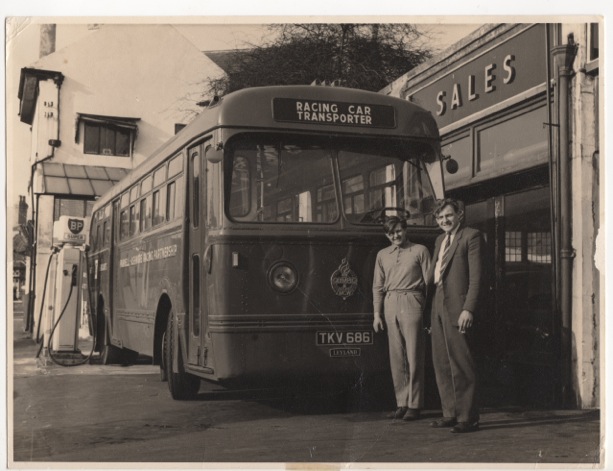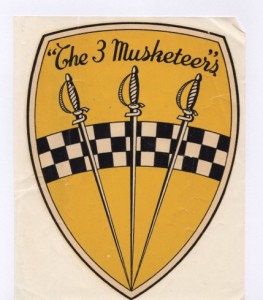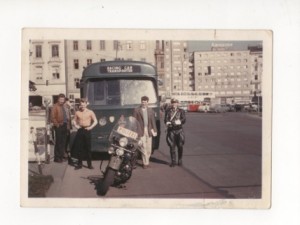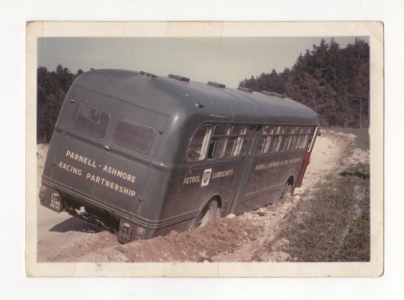The true story of the Leyland Olympic Bus (lhd) with semi-automatic gearbox converted into a 4 racing car transporter.
By Gerry Ashmore who raced alongside Tim Parnell during the 1960s. His story underlines racing in Formula 1 back then compared to the executive jets of today.
[Row][Column]
This all started because my father, Joe Ashmore, purchased from the late Reg Parnell his son Tim’s old Cooper — Climax F11 car for me to drive.
Joe and Reg had been friends and business partners for many years so it seemed to be a good idea for Tim and myself to form a partnership and share the cost of buying a suitable vehicle to convert into a car transporter. Because the Ashmores where in the Garage business and transport with sales of commercial vehicles we had very good connections and knew where to go to buy a suitable vehicle, Mr Joe knew a man in Stratford-on-Avon who was also a friend of many years and had purchased from the Leyland Motor Company an ex prototype bus its year was early 1950’s which was built for the Cuban Government order. This vehicle was fitted with a 6 cylinder diesel engine lying on its side under the floor just a little before mid-ship. This engine was connected to a very special semi-automatic gearbox made by Coventry Self Change Gears Ltd designed for public service vehicles to make stopping and starting in heavy traffic so much easier for the driver.

It had on the side of the steering column, on a moulded bracket, a small gear change lever about 50mm high to select any of the 4 gears plus the reverse. The gears were engaged without a clutch pedal so it was fitted with a fluid flywheel which gave a smooth start and change. This gearbox required air pressure of 120 lbs to engage the gears and hold them in mesh, but I was not told that, should you lose the air, the gears went into the neutral position. Also the braking system was fully air powered, with a manual hand brake lever. You must remember that in the late ‘40’s and ‘50’s most commercial vehicles had straight hydraulic brakes then they became air-assisted , and a few had full air brake system as did this bus.
I collected the bus with Mr Joe and drove it back to our garage in West Bromwich then I took out all the seats and had one of our men cut out the rear panel to make two opening doors.
Then I bought a lot of used aluminium ’u’ & RSJ sections and 4 new lengths of aluminium 250mm x 50mm. Themade RSl’s I made into uprights and made a frame work from the rear doors forward. With the 4 lengths of new U section I made the front two fixed high enough for a single seater car to pass under it with one above it. The rear ones I made lift using a small hand winch, so in effect, the bus could carry 4 cars.
At the end of the 1960 season I sold the Cooper and purchased a new Lotus 18. Having connections with the Dunlop tyre company in Birmingham I purchased from their test fleet department two Standard Vanguard diesel-engined estate cars with a million miles on each. These had been driven day and night from new, testing tyres, had been well maintained and, painted with tyre black, looked like no other car. Having sold one in Lincolnshire I passed the late Chris Summers garage in the Village of Ansty near Coventry.
I decided to call in and see what business could be done. Chris had taken the Climax FPF engine, which was on SU carburettors, out of his Cooper and had replaced it with a V8 Chevrolet. It was the first of the big banger-engined cars, but he sadly crashed in it and was killed.
However I needed an FPF Climax for my Lotus and we did a deal for the second Standard Vanguard.
The bus was repainted in Green and sign written.The entry doors were the air operated fold back type, but could be opened without air if required. It was a left hand drive model for Cuba and behind on either side over the front wheel arches two long side mounted seats. As I did almost all the driving my wife Yvonne and the two mechanics sat on one side whilst Tim Parnell and young David Whitehouse, who was later to run his own tuning business in Derby, sat on the other.
Tim Parnell and I had no written contract for our partnership and so we decided to include Andre Pilette in our team! We called ourselves ‘the three Musketeers’ and Andre made us a logo for this!

So we went to Ireland for two races, one at Dunboyne, which was a proper road circuit, and one at Phoenix Park. I won the Dunboyne scratch race in the Cooper but lost the handicap by a second or two, and we then had a week’s holiday before the Phoenix park race. So I said let’s go to the park and have a look at the circuit.
It was a warm July evening and we parked the bus near a large statue of the Duke of Wellington on a horse and left to walk the circuit which took over an hour. When we got back to the bus it was getting dark so we drove back to our hotel at the Lucan Spa only to read in the papers the next morning that Wellington’s statue had been blown up during the night and that no one had seen anything except for a green bus which had been parked near it for a long time!
As it turned out the IRA had blown it up and as we went back for the race we saw that it had gone completely. I led from start to finish with Tim in third place. Unfortunately Andre Pilette blew his engine in the Emeryson.
We set off for Monte Carlo as there was a chance that the Monaco Automobile Club would accept the two of us for the grand prix since Tim’s father, Reg ,was running the Yeoman Credit Racing team. When we arrived Tim went and spoke with the organisers but they could not fit either of us in.
So we then set off for Naples and drove over the mountains to the Autostrada Del Sol
Having spent a long time going up one Col we reached the highest point and travelled on the flat for a number of miles.
The weather was hot and sunny and on the right hand side was the Mediterranean Sea which was a long way down if one should have gone over the side. In those days there were no such things as steel crash barriers, just black & white painted stones every few metres. We had travelled some miles and I could see that the road started to go downhill quite shallowly at first but then the gradient increased and I could see in the distance a Red Truck towing a draw bar trailer working his way up towards us.
Then, as I started to check the speed with a dap on the brake pedal, I noticed they did not have their normal bite so I looked at the air gauges and could see them going down fast , I then said to everyone we have lost the brakes, the gearbox has gone into neutral we are a runaway so hold tight!
[/Column][Column]
The speedo only read to 60 MPH and the needle had gone past that so I had no idea of our speed. It was increasing and as the bends came up I tried to keep the bus on the racing line because a problem we had suffered in the past was tyre failure as we had a mix of different makes! As there was no power steering it was difficult to steer so my big worry was blowing a front and being taken over the edge. So I kept my right foot hard on the throttle in neutral, and was ready with my left to hit the brake pedal if any air should come back into the tanks.
By this time of course, the oncoming truck was getting closer and I knew I would meet him on one of the bends. Of course this is exactly what happened. He couldn’t go anywhere and I was on his side of the road. I could see the drivers face and his eyes where sticking out because as far as he was concerned it was going to be a head on accident.
But then, in the last few seconds I could see the one air tank needle had lifted a little off the bottom and I knew I might have one dab of the brake pedal so at the very last moment I hit the brake and it just bit. At the same time I turned the wheel to the right and missed the truck with the front of the bus but towards the rear I took his mirrors off and then I knew I would have to hit the stone markers. Missing them with the front wheels and letting the rear wheels hit them sort of checked the speed while the stones went over and down to the sea one after the other.
I expected the rear axle to shear the spring centre pin, and if this had happened then the axle would move backwards on the right side taking the rear of the bus to the edge however the road flattened out and we were now at sea level.There was nothing I could do to stop the bus except just let it roll to a standstill in a layby on the left hand side.
We all got out and I could hear air escaping and I said to Tim ‘that’s a tyre going down’. When I turned towards the sea there was a beach restaurant. I could not believe our luck so we went across and had lunch. On returning to the bus I checked the tyres which were all OK, so I had to sort out the loss of air pressure and started at the engine. On the engine was a compressor driven off the timing gear chest and from the compressor was a rubber hose pipe about 300mm long which then joined a steel pipe that ran inside the chassis to the front. Mounted behind the front body panel were two air tanks.
What had happened was that with the heat and the continuous high engine RPM going uphill the inside of the rubber pipe broke up and as the rubber broke up the air went into the tanks and at 120lbs PSI the air tank valves blew off allowing bits of the rubber debris to get under the valve seats letting the air escape; then the pipe finally split open.
I took the tanks off cleaned the valves, washed out the tanks, refitted them and took a piece of racing oil Cooler rubber hose and fitted that to the compressor.
We eventually arrived at Naples on the practice day for the GP of Napoli and drove the racing cars to the circuit on the road.

The bus followed us driven by one of the Australian boys who, in the traffic, kept touching the brake pedal and exhausted the air. As a result he lost the drive and brakes and ran into the rear of a Fiat 500. The driver was a little upset got out with his handbrake on without realising his Fiat was now on a steep hill holding about 8 tonnes of bus!
Anyway because we had rented some floor space from the local Fiat garage we arranged for his car to be rebuilt overnight , fantastic service and the cost was very cheap so Tim and I could not pay them quick enough.
In practice for race I got pole in about 6 laps and spent almost two days sitting on the pit counter. Then in the race the gear stick broke off as I was about to take the lead from the works Ferrari of Giancarlo Baghetti so I had to settle for second place.
On our return to West Bromwich I took the Bus to the Leyland Service department at Oldbury and told them what had happened. Because of this they and the Westinghouse Company, who made most of the air brake systems for most makes of Commercial vehicles at that time designed what is known as air spring brake cylinders. This means that the air pressure needs to build up before the brakes can be released. Once released the air holds the brakes off unless the driver moves the brake pedal. This meant that if the air goes the brakes come on hard and will not release until the pressure is back in the system. We sold the bus in 1962 to Peter Sargent who wanted it to transport his Lister —Jaguar to Le Mans.
On leaving us he was almost at his destination when, on a 3-lane road, another vehicle T boned the bus as the driver had suffered a heart attack. But its history did not finish there.

Peter sold the truck to Tony Dean and I was at Brands Hatch not long afterwards where my paddock space was at the top of the hill and Tony Dean was down at the bottom. Tony had a bad day smashing both his cars at Paddock Bend. We all helped lift the cars into the bus for him. Then when the racing was over Tony’s driver, an elderly man, started to drive up the hill out of the Paddock but in traffic he did the same as boys at Naples but this time it went down the hill backwards running over a trailer, hitting a number of vehicles and finished up hitting the rear of a Large Ford 16 ton Luton Van. Behind the van was a Mark II Jaguar with the owners’ wife feeding their new born baby!
The Jaguar was pushed through a wattle wood fence that was about 30 meters above a sheer drop.The car was so far over the edge they could not get the mother and baby out until it was towed backwards!
Thankfully that was the last I ever heard of the bus.
[/Column][/Row]
